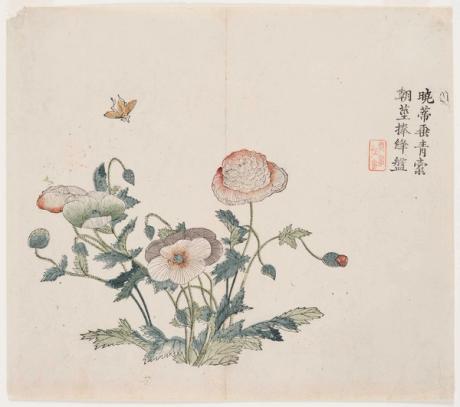
The exhibition Objects of Addiction: Opium, Empire, and the Chinese Art Trade at Harvard Art Museums (until 14 January 2024) draws comparisons between the opium crisis in the 19th century and today’s opioid crisis. It highlights the role of Massachusetts merchants in the lucrative but illicit opium trade and scrutinises the cultural and human impact of addiction. Programming in conjunction with the exhibition includes a public space for reflection and destigmatisation, as well as distribution of free Narcan nasal spray—a treatment for preventing fatal opioid overdoses—and training clinics for overdose prevention.
Sarah Laursen, the museums’ associate curator of Chinese art, says that the exhibition is the result of a deep dive into the art, special collections and historic archives at Harvard and other institutions, as well as a collaboration with stakeholders including students, faculty, medical and public health professionals, the group Harvard College Overdose Prevention and Education Students and community members.
“It’s valuable to use the history as a lens for the present,” Laursen says, adding that aggressive drug industries and the exploitation of vulnerable people are situations that repeat throughout history.
Profiting from drugs trade
On display are art, objects, Buddhist sculptures and murals, jades, bronzes and historic records that show both the individual cost of addiction and the vast scale of the opium supply chain. Prominent Massachusetts merchant families profited from the trade, including Hiram Fogg, brother of William Hayes Fogg—for whom Harvard’s Fogg Museum was named. Their offices can be seen in a 19th-century painting of the Port of Shanghai (by an unidentified artist), a treaty port from the first Opium War (1839-42).
The human cost of the opium trade is well documented. The Qing dynasty was crippled by both wars and a widespread addiction that claimed an estimated 10% of its population—around 40 million citizens. This destabilisation left many important heritage sites vulnerable to a growing hunger for exotic objects of Chinese craftsmanship and heritage. The Peabody Essex Museum and Harvard were among the earliest institutions to acquire such artefacts.
One well-known example is the looting and destruction of the Old Summer Palace in Beijing by Anglo-French forces, in which countless treasures were dispersed or destroyed. The site, now a public park of ruins, is a painful reminder of this history. “It has become a very potent symbol of Western imperialism in China,” Laursen says.
The Mogao Caves, a centuries-old Buddhist site, also bear evidence of unchecked cultural treasure hunting. Two sections lifted from one of the cave’s murals 100 years ago by the Harvard professor Langdon Warner are on display in the exhibition. Adjacent to them is a large-scale photograph of the original mural with the areas of damage clearly defined. The mural sections’ ownership remains controversial, and the defacing serves as a teaching tool in both countries.
Reduce stigma, save lives
A third and important element of the exhibition is to acknowledge the opioid crisis today, which caused an estimated two thirds of the more than 107,000 overdose deaths in the US last year. At least three million people in the country have at some point struggled with opioid use.
Harvard’s ties to the addiction crisis, then and now, are complicated. Some works in Objects of Addiction are from the Harvard Art Museums/Arthur M. Sackler Museum collection. The Sackler name is synonymous with the opioid crisis and is featured prominently on Harvard Art Museums’ walls. Harvard has been under pressure for years to remove the Sackler name, including from Prescription Addiction Intervention Now (Pain), the activist group founded by the artist Nan Goldin.
Laursen acknowledges that, for a visitor, seeing the name that they associate with addiction or the death of a loved one could be traumatising. “I want people to walk into our space and feel safe and feel respected,” she says.
Community training and healing
To that end, Objects of Addiction was designed as not only an exhibition but also a dialogue with the community to encourage understanding and healing. The programming includes talks and tours as well as roundtable discussions and drama therapy workshops led by the collective 2nd Act.
But perhaps the most impactful outcome for this exhibition is in creating awareness of the availability of the opioid-overdose reversing nasal spray Narcan. In collaboration with Cambridge Public Health Department and Somerville Health and Human Services, the museum is hosting several free Narcan nasal spray distribution and training sessions, starting this month.
Danielle McPeak, a prevention and recovery specialist at the Cambridge Public Health Department, is offering the hour-long, in-person sessions to the Harvard Art Museums community. “I am hoping for a very good turnout,” she says. She explains that the best thing people can do if they witness a potential opioid overdose, after calling emergency services, is to be prepared with a life-saving dose of Narcan nasal spray. Already, Harvard Art Museums staff have received training and been supplied with Narcan.
“We really want to create more of a reciprocal relationship with the community,” Laursen says. “And finding ways to use these public health strategies to help people was always part of the equation.”
- Objects of Addiction: Opium, Empire, and the Chinese Art Trade, Harvard Art Museums, Cambridge, Massachusetts, until 14 January 2024










